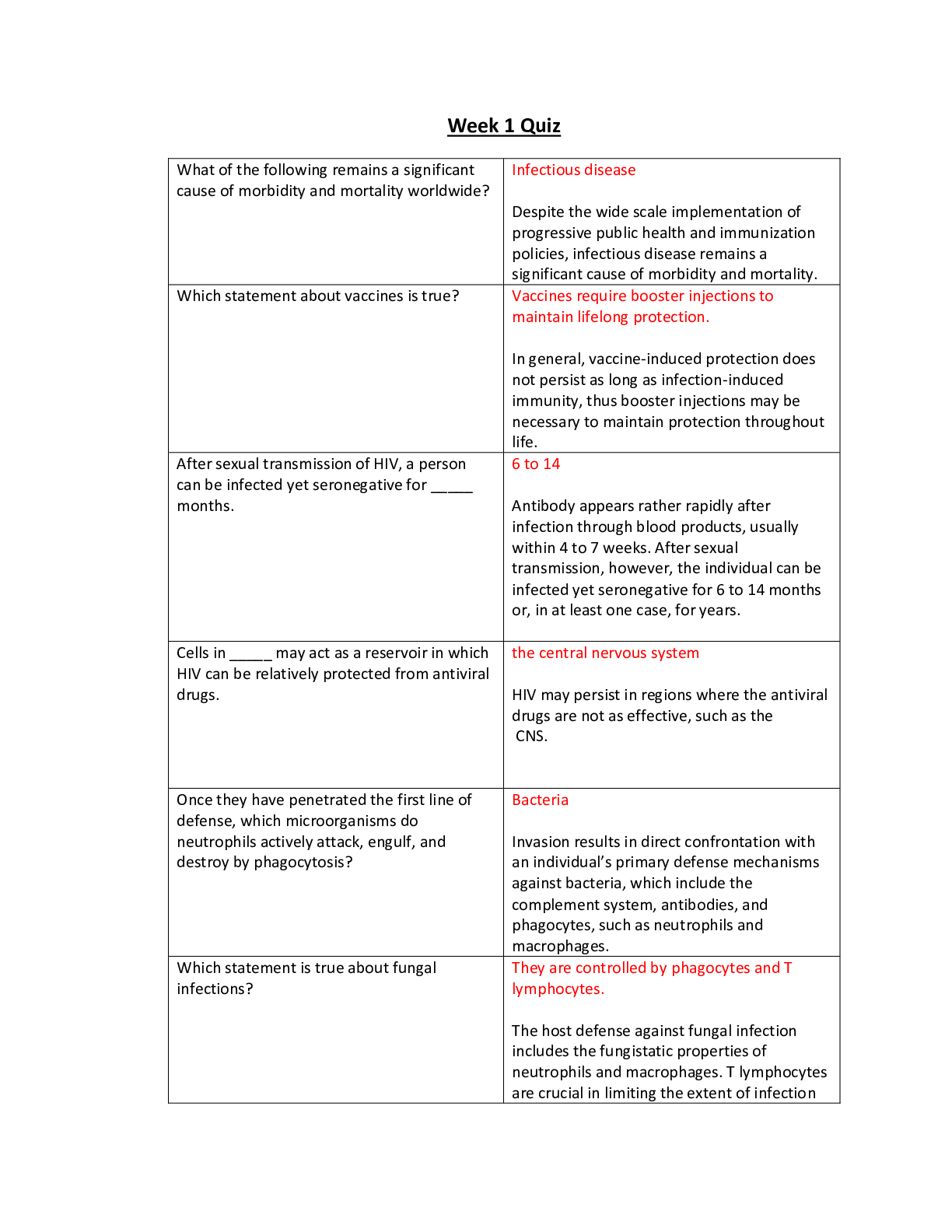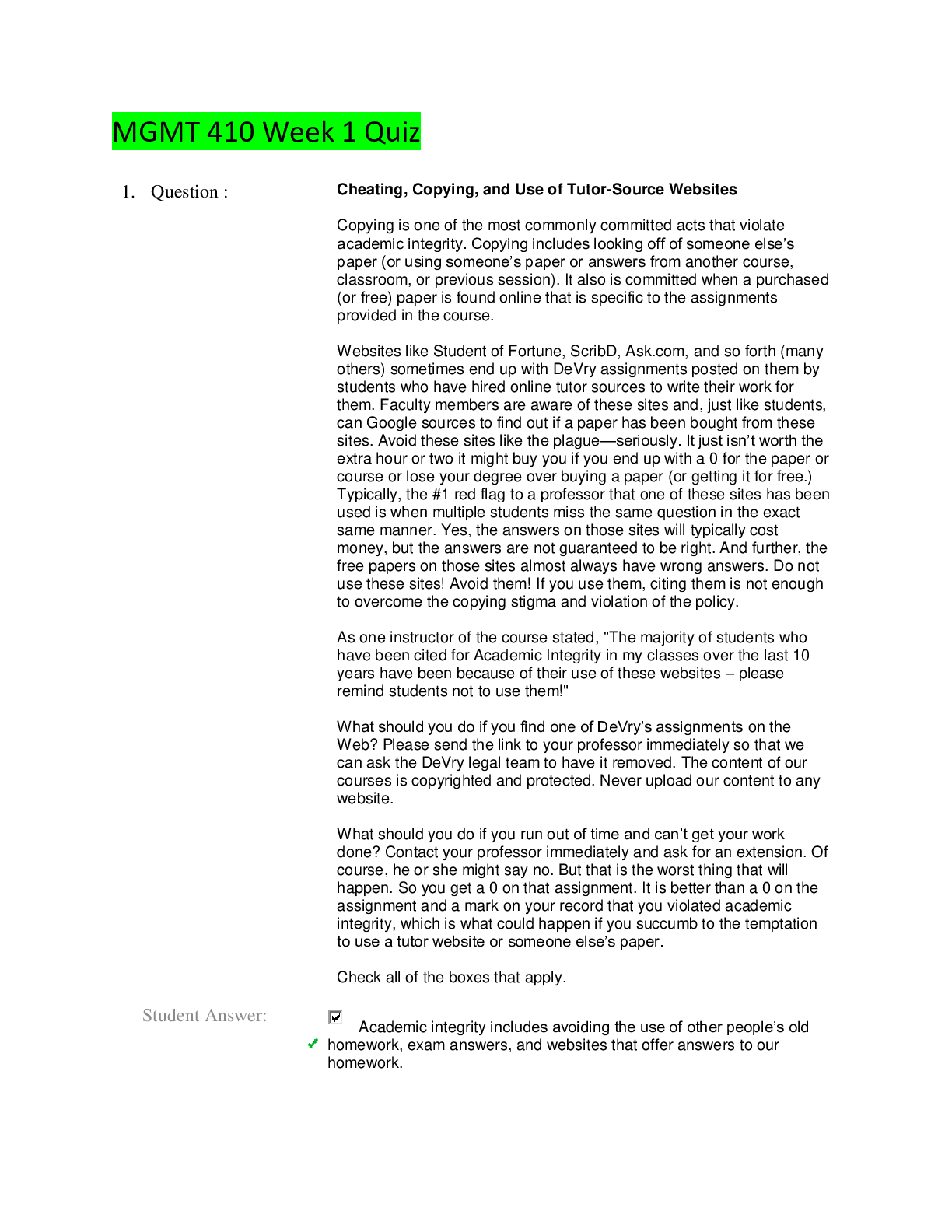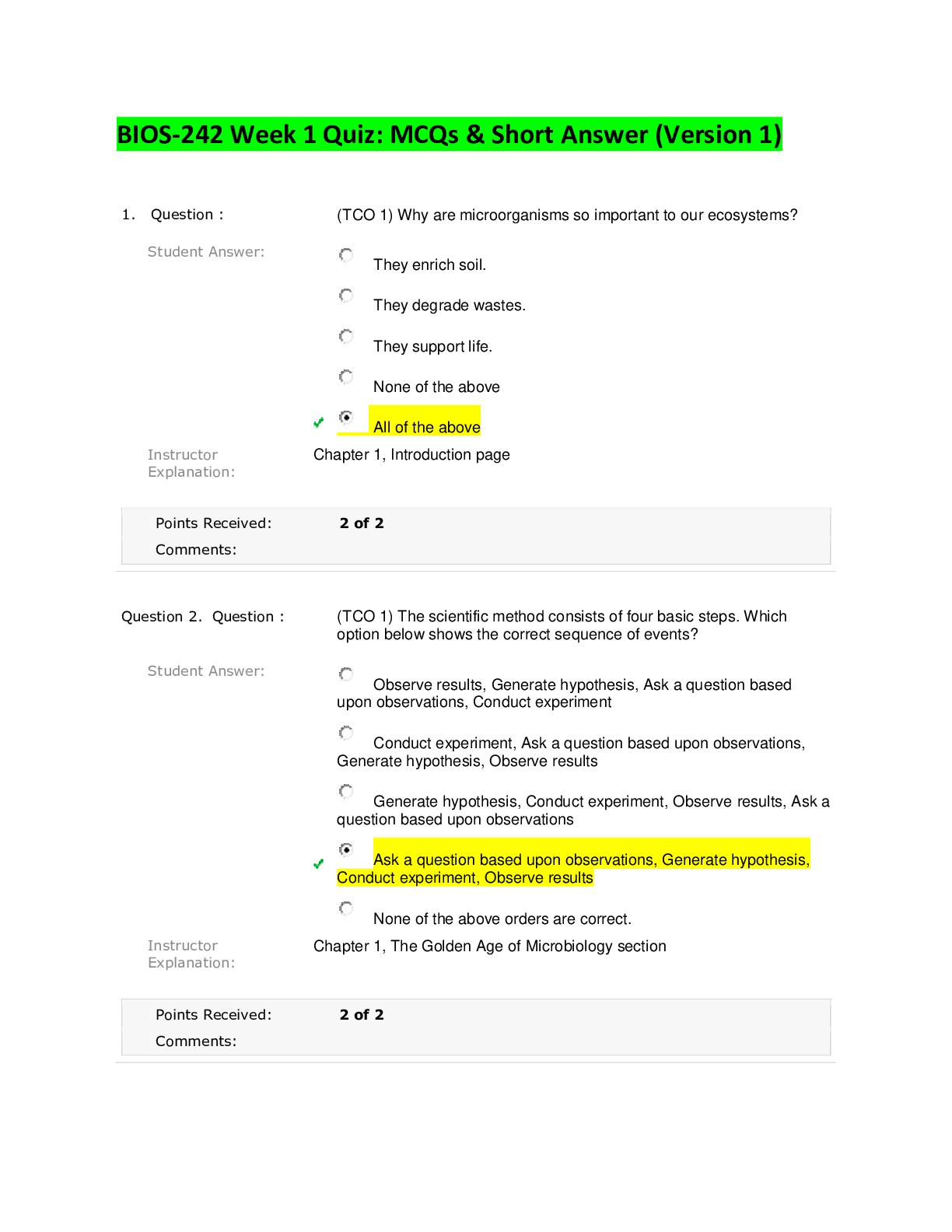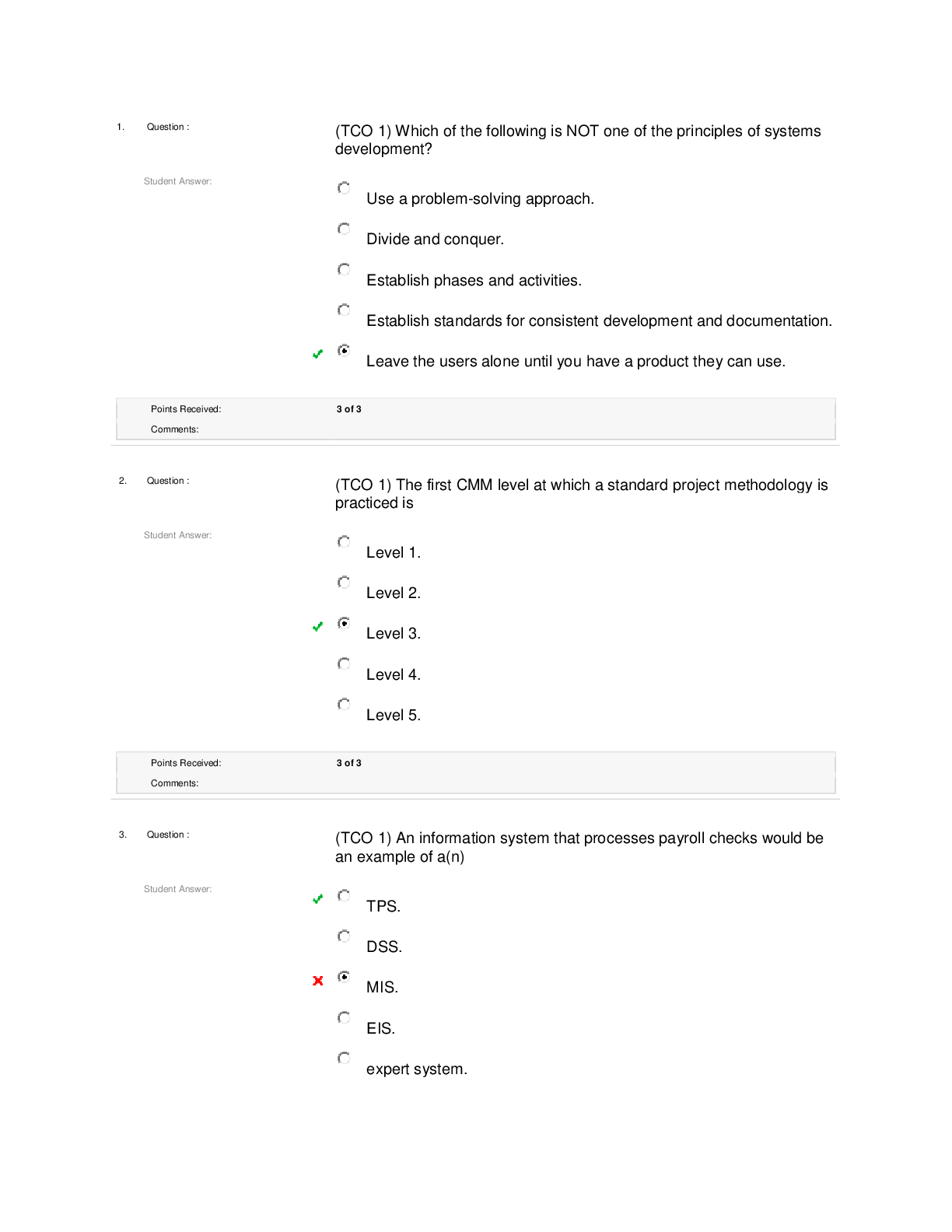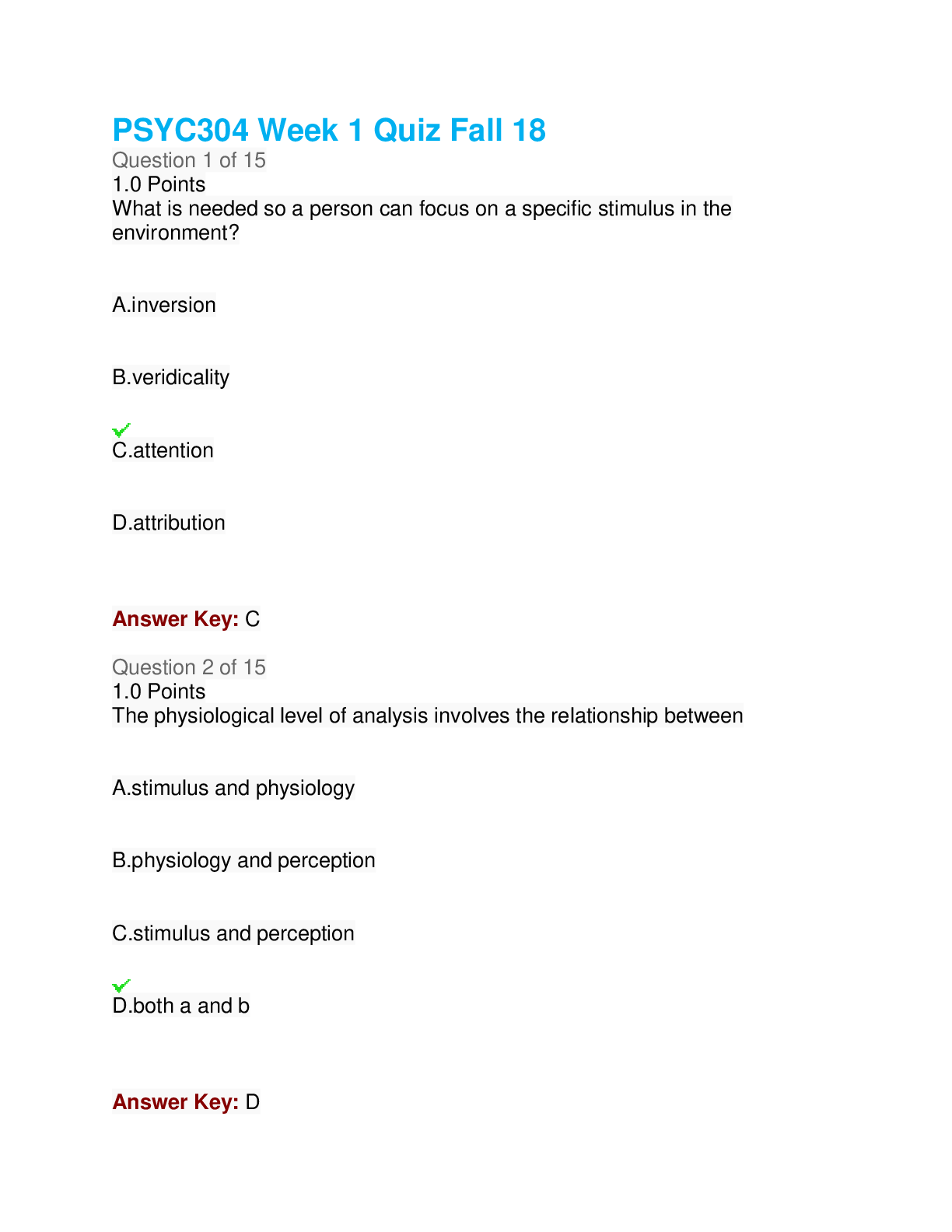NR 507 Week 1 Quiz (Questions & Answers) All 100 % Correct
Document Content and Description Below
NR 507 Week 1 Quiz 1. Q : Which statement is true about fungal infections? Student Answer: They occur only on skin, hair, & nails. They are controlled by phagocytes & T lymphocytes.... They result in release of endotoxins. They are prevented by vaccines. Instructor Explanation: The host defense against fungal infection includes the fungistatic properties of neutrophils & macrophages. T lymphocytes are crucial in limiting the extent of infection & producing cytokines to further activate macrophages. Points Received: 2 of 2 Comments: Q 2. Q : Once they have penetrated the first line of defense, which microorganisms do neutrophils actively attack, engulf, & destroy by phagocytosis? Student Answer: Bacteria Fungi Viruses Mycoplasma Instructor Explanation: Invasion results in direct confrontation with an individual’s primary defense mechanisms against bacteria, which include the complement system, antibodies, & phagocytes, such as neutrophils & macrophages. (See Chapters 6, 7, & 8). Points Received: 2 of 2 Comments: Q 3. Q : After sexual transmission of HIV, a person can be infected yet seronegative for _____ months. Student Answer: 1 to 2 6 to 14 18 to 20 24 to 36 Instructor Explanation: Antibody appears rather rapidly after infection through blood products, usually within 4 to 7 weeks. After sexual transmission, however, the individual can be infected yet seronegative for 6 to 14 months or, in at least one case, for years. Points Received: 2 of 2 Comments: Q 4. Q : What of the following remains a significant cause of morbidity & mortality worldwide? Student Answer: Starvation Traumatic injury Cardiovascular disease Infectious disease Instructor Explanation: Despite the wide scale implementation of progressive public health & immunization policies, infectious disease remains a significant cause of morbidity & mortality. Points Received: 2 of 2 Comments: Q 5. Q : Cells in _____ may act as a reservoir in which HIV can be relatively protected from antiviral drugs. Student Answer: the central nervous system bone marrow the thymus gl& the lungs Instructor Explanation: HIV may persist in regions where the antiviral drugs are not as effective, such as the CNS. Points Received: 2 of 2 Comments: Q 6. Q : Which statement about vaccines is true? Student Answer: Most bacterial vaccines contain attenuated organisms. Most viral vaccines are made by using dead organisms. Vaccines require booster injections to maintain lifelong protection. Vaccines provide effective protection for all people against viruses, bacteria, & fungal infections. Instructor Explanation: In general, vaccine-induced protection does not persist as long as infection-induced immunity, thus booster injections may be necessary to maintain protection throughout life. Points Received: 2 of 2 Comments: Q 7. Q : The class of antibody involved in type I hypersensitivity reactions is Student Answer: IgA. IgE. IgG. IgM. Instructor Explanation: Type I reactions are mediated by antigen-specific IgE & the products of tissue mast cells (see Figure 8-1). Points Received: 2 of 2 Comments: Q 8. Q : In which primary immune deficiency is there a partial to complete absence of T-cell immunity? Student Answer: Bruton disease DiGeorge syndrome Reticular dysgenesis Adenosine deaminase (ADA) deficiency Instructor Explanation: The principal immunologic defect in DiGeorge syndrome is the partial or complete absence of T-cell immunity. Points Received: 0 of 2 Comments: Q 9. Q : During an IgE-mediated hypersensitivity reaction, what causes bronchospasm? Student Answer: Bronchial edema caused by chemotactic factor of anaphylaxis Bronchial edema caused by binding of the cytotropic antibody Smooth muscle contraction caused by histamine bound to H1 receptors Smooth muscle contraction caused by histamine bound to H2 receptors Instructor Explanation: Acting through the H1 receptors, histamine contracts bronchial smooth muscles, causing bronchial constriction; increases vascular permeability, causing edema; & causes vasodilation, increasing blood flow into the affected area (Figures 6-3 & 6-10). Points Received: 2 of 2 Comments: Q 10. Q : Deficiencies in which element can produce depression of both B- & T-cell function? Student Answer: Iron Zinc Iodine Magnesium Instructor Explanation: Deficient zinc intake can profoundly depress T- & B-cell function. Points Received: 2 of 2 Comments: Q 11. Q : Hypersensitivity is best defined as a(n) Student Answer: disturbance in the immunologic tolerance of self-antigens. immunologic reaction of one person to the tissue of another person. altered immunologic response to an antigen that results in disease. undetectable immune response in the presence of antigens. Instructor Explanation: Hypersensitivity is an altered immunologic response to an antigen that results in disease or damage to the host. Points Received: 2 of 2 Comments: Q 12. Q : In a type II hypersensitivity reaction, when soluble antigens from infectious agents enter circulation, tissue damage is a result of Student Answer: complement-mediated cell lysis. phagocytosis by macrophages. phagocytosis in the spleen. neutrophil granules & toxic oxygen products. Instructor Explanation: The components of neutrophil granules, as well as the several toxic oxygen products produced by these cells, damage the tissue. Points Received: 2 of 2 Comments: Q 13. Q : What is the mechanism in type III hypersensitivity reactions? Student Answer: Antibodies coat mast cells by binding to receptors that signal its degranulation followed by discharge of preformed mediators. Antibodies bind to soluble antigens that were released into body fluids & the immune complexes are deposited in the tissues. Cytotoxic T lymphocytes or lymphokine-producing Th1 cells attack & destroy cellular targets directly. Antibodies bind to the antigen on the cell surface. Instructor Explanation: Most type III hypersensitivity diseases are caused by antigen-antibody (immune) complexes that are formed in the circulation & deposited later in vessel walls or extravascular tissues (Figure 8-3). Points Received: 2 of 2 Comments: Q 14. Q : During a stress response, increased anxiety, vigilance, & arousal is prompted by Student Answer: norepinephrine. epinephrine. cortisol. ACTH. Instructor Explanation: Norepinephrine release promotes arousal, increased vigilance, increased anxiety, & other protective emotional responses. Points Received: 2 of 2 Comments: Q 15. Q : Stress-age syndrome results in decreased Student Answer: catecholamines. ACTH. cortisol. immune system. Instructor Explanation: Immunodepression is one of the characteristic changes seen in stress-age syndrome. Points Received: 2 of 2 Comments: Q 16. Q : Which hormone increases the formation of glucose from amino acids & free fatty acids? Student Answer: Epinephrine Norepinephrine Cortisol Growth hormone Instructor Explanation: One of the primary effects of cortisol is the stimulation of gluconeogenesis or the formation of glucose from noncarbohydrate sources, such as amino or free fatty acids in the liver. Points Received: 2 of 2 Comments: Q 17. Q : What effect does estrogen have on lymphocytes? Student Answer: Depression of B cells & enhancement of T cells Depression of T cells & enhancement of B cells Depression of B cells & T cells Enhancement of B cells & T cells Instructor Explanation: Estrogens generally are associated with a depression of T-cell–dependent immune function & enhancement of B-cell functions. Points Received: 2 of 2 Comments: Q 18. Q : Intestinal polyps are benign neoplasms & the first stage in development of colon cancer. These findings support the notion that Student Answer: cancers of the colon are more easily diagnosed in the benign form because they can be visualized during colonoscopy. an accumulation of mutations in specific genes is required for the development of cancer. tumor invasion & metastasis progress more slowly in the gastrointestinal tract. apoptosis is triggered by diverse stimuli including excessive growth. Instructor Explanation: It is understood that multiple genetic mutations are required for the evolution of full-blown cancer. The remaining options do not address the progression of benign to metastatic tumors. Points Received: 2 of 2 Comments: Q 19. Q : Which of the following cancers originate from connective tissue? Student Answer: Osteogenic sarcoma Basal cell carcinoma Multiple myeloma Adenocarcinoma Instructor Explanation: Cancers arising from connective tissue usually have the suffix "-sarcoma.” Points Received: 2 of 2 Comments: Q 20. Q : Which of the viruses below are oncogenic DNA viruses? Student Answer: Papovaviruses, adenoviruses, & herpesviruses Retroviruses, papovaviruses, & adenoviruses Adenoviruses, herpesviruses, & retroviruses Herpesviruses, retroviruses, & papovaviruses Instructor Explanation: Papovaviruses, adenoviruses, & herpesviruses are oncogenic DNA viruses; the remaining examples do not fall into this category. Points Received: 2 of 2 Comments: Q 21. Q : Cells from a muscle tumor show a reduced ability to form new muscle & appear highly disorganized. This is an example of Student Answer: dysplasia. hyperplasia. myoplasia. anaplasia. Instructor Explanation: Anaplasia is defined as the loss of cellular differentiation, irregularities of the size & shape of the nucleus, & loss of normal tissue structure. In clinical specimens, anaplasia is recognized by a loss of organization & a marked increase in nuclear size with evidence of ongoing proliferation. The remaining options refer to very specific changes in the cell. Points Received: 2 of 2 Comments: Q 22. Q : Which of the following represents the correct nomenclature for benign & malignant tumors of adipose tissue, respectively? Student Answer: Liposarcoma, lipoma Lipoma, liposarcoma Adisarcoma, adipoma Adipoma, adisarcoma Instructor Explanation: In general, cancers are named according to the cell type from which they originate (e.g., lip), whereas benign tumors use the suffix “-oma.” Points Received: 2 of 2 Comments: Q 23. Q : In chronic myeloid leukemia (CML), a piece of chromosome 9 fuses to a piece of chromosome 22. This is an example of which mutation of normal genes to oncogenes? Student Answer: Point mutation Chromosome fusion Gene amplification Chromosome translocation Instructor Explanation: Chromosome translocations, in which a piece of one chromosome is translocated to another chromosome, can activate oncogenes. In a different type of leukemia, CML, a specific chromosome translocation is almost always present. The remaining options are not best depicted by CML. Points Received: 2 of 2 Comments: Q 24. Q : Tobacco smoking is associated with cancers of all of the following except Student Answer: lung. skin. bladder. kidney. pancreas. Instructor Explanation: Smoking causes cancer of the lung & is associated with cancers of the renal gl&, bladder, penis, oral cavity, pharynx, larynx, nasal cavities, sinuses, esophagus, stomach, liver, kidney, uterus, & myeloid leukemia. There are no data currently linking the tobacco smoking skin cancer. Points Received: 2 of 2 Comments: Q 25. Q : Childhood exposure to all of the following risk factors increases susceptibility to cancer except Student Answer: drugs. ionizing radiation. cigarette smoke. viruses. Instructor Explanation: Childhood exposure to ionizing radiation, drugs, or viruses has been associated with the risk of developing cancer. Although unhealthy, there are no current data to identify cigarette smoke as a risk factor for childhood cancer. Points Received: 2 of 2 Comments: [Show More]
Last updated: 2 years ago
Preview 1 out of 1 pages

Buy this document to get the full access instantly
Instant Download Access after purchase
Buy NowInstant download
We Accept:

Reviews( 0 )
$17.00
Can't find what you want? Try our AI powered Search
Document information
Connected school, study & course
About the document
Uploaded On
Oct 12, 2020
Number of pages
1
Written in
Additional information
This document has been written for:
Uploaded
Oct 12, 2020
Downloads
0
Views
97



.png)



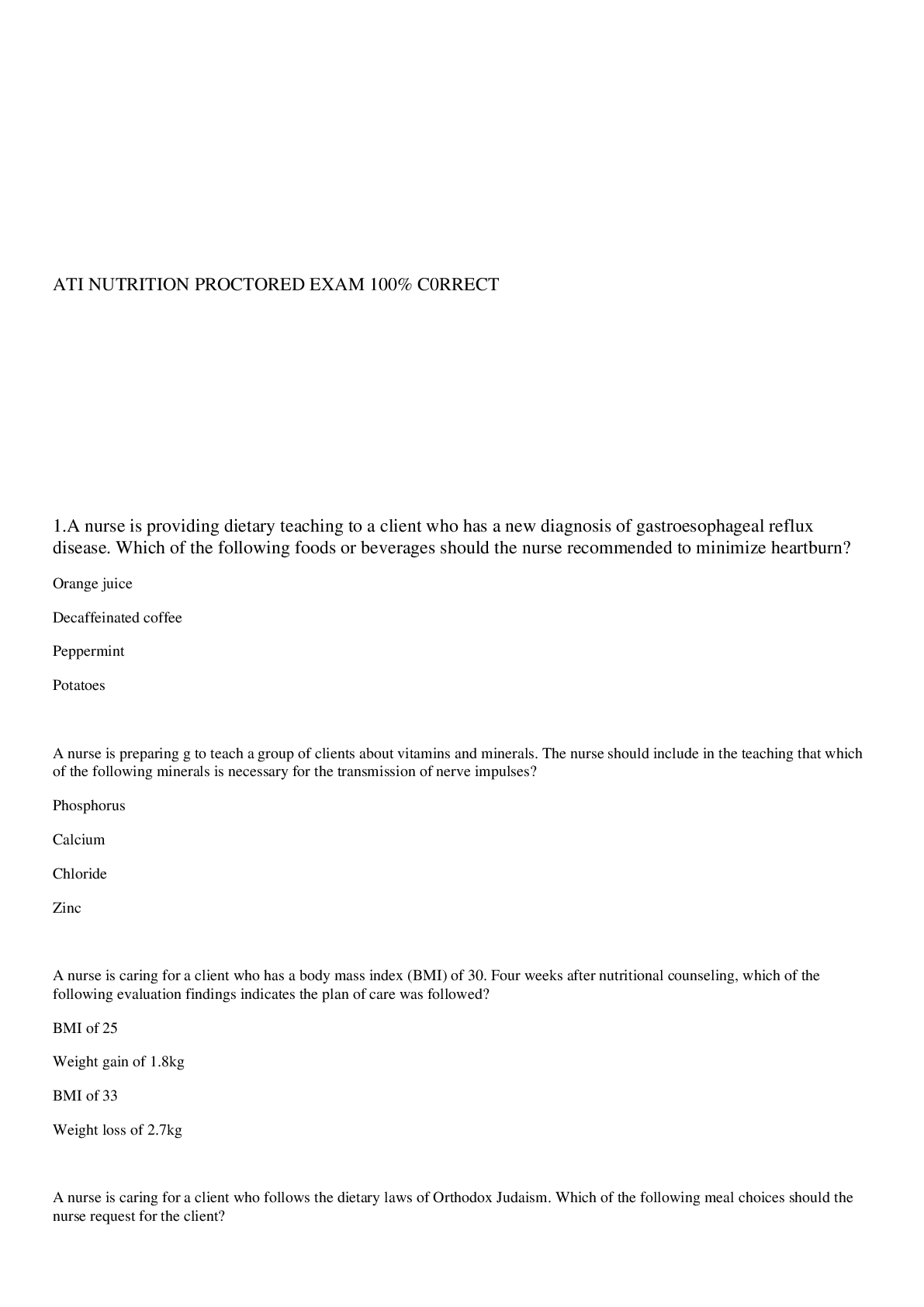
.png)
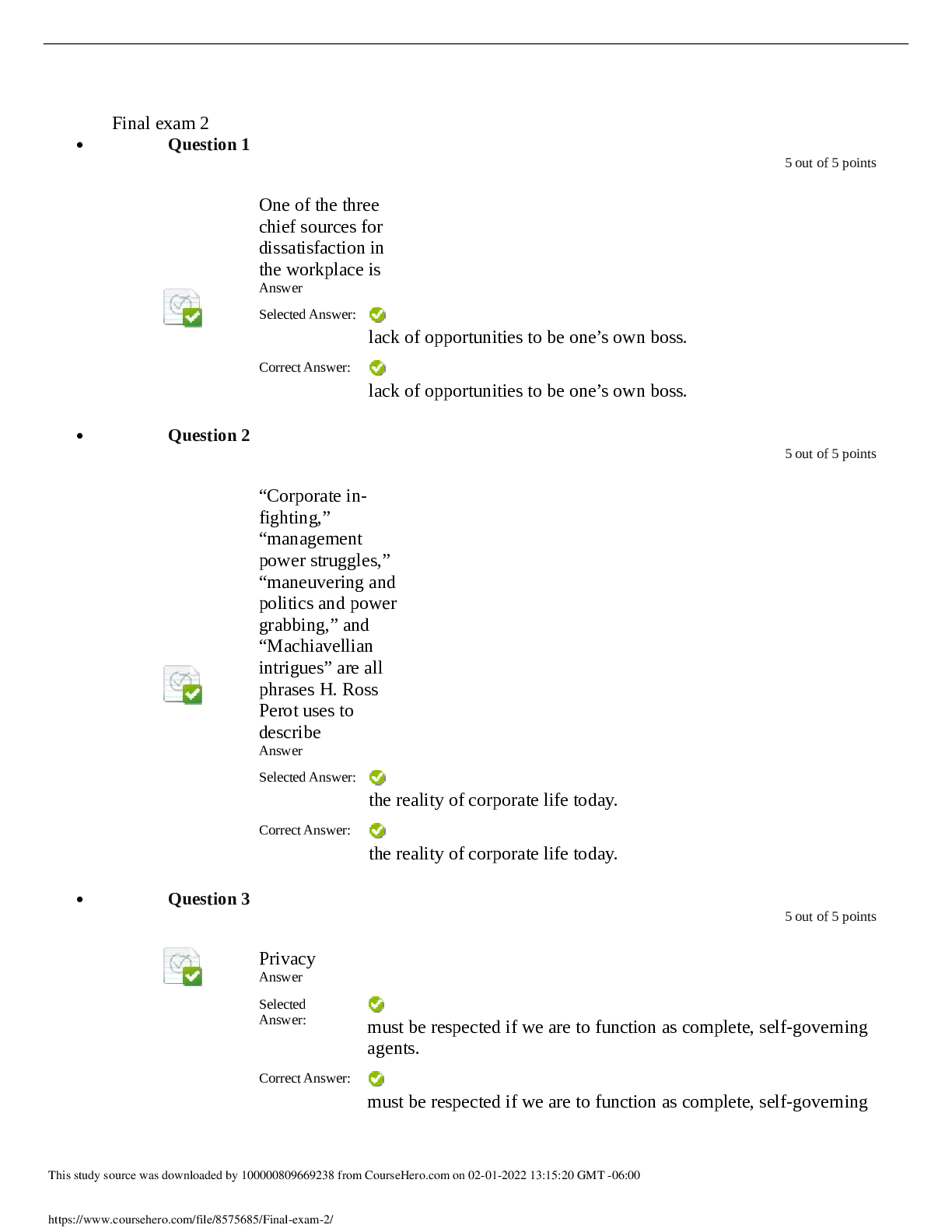
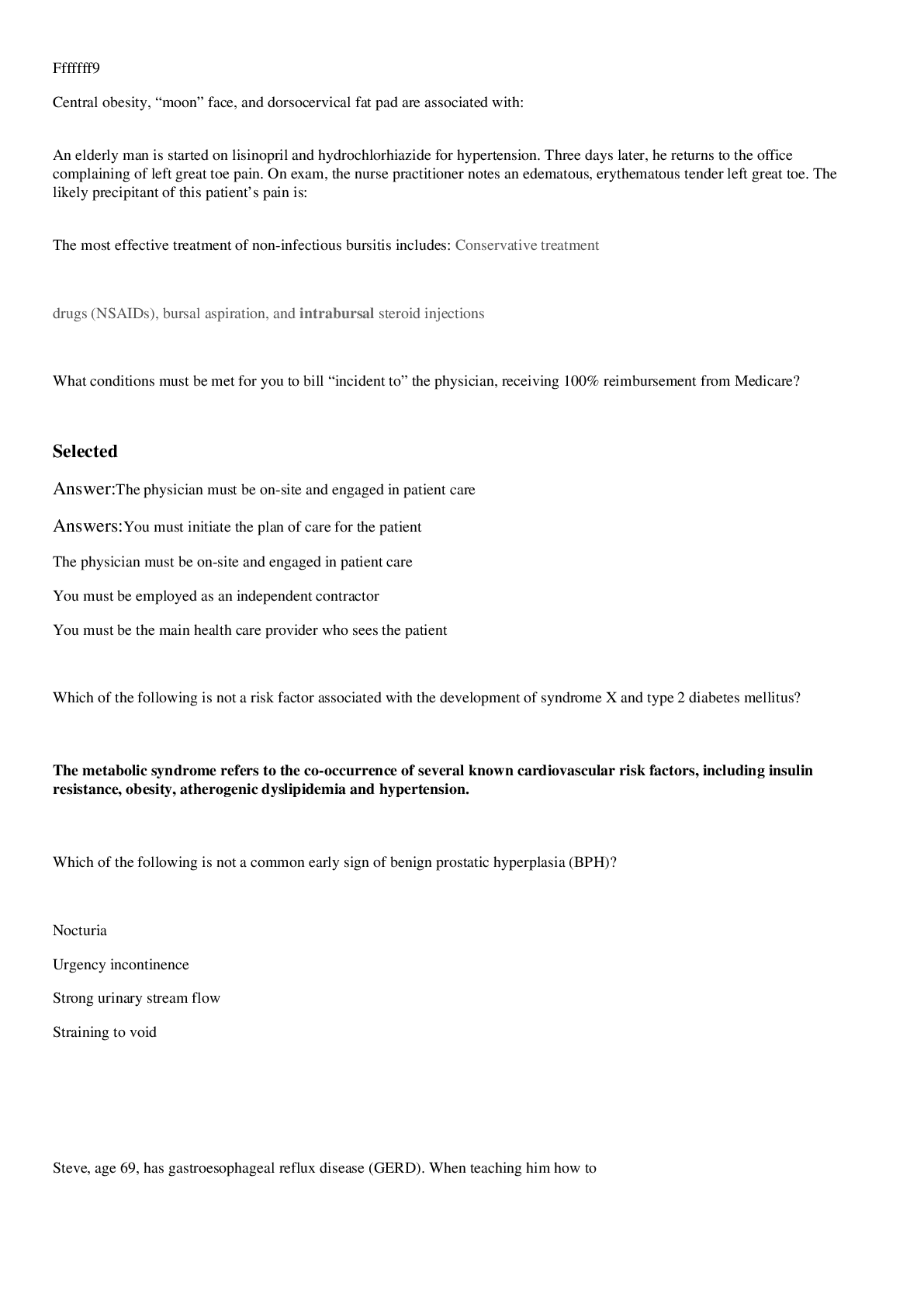
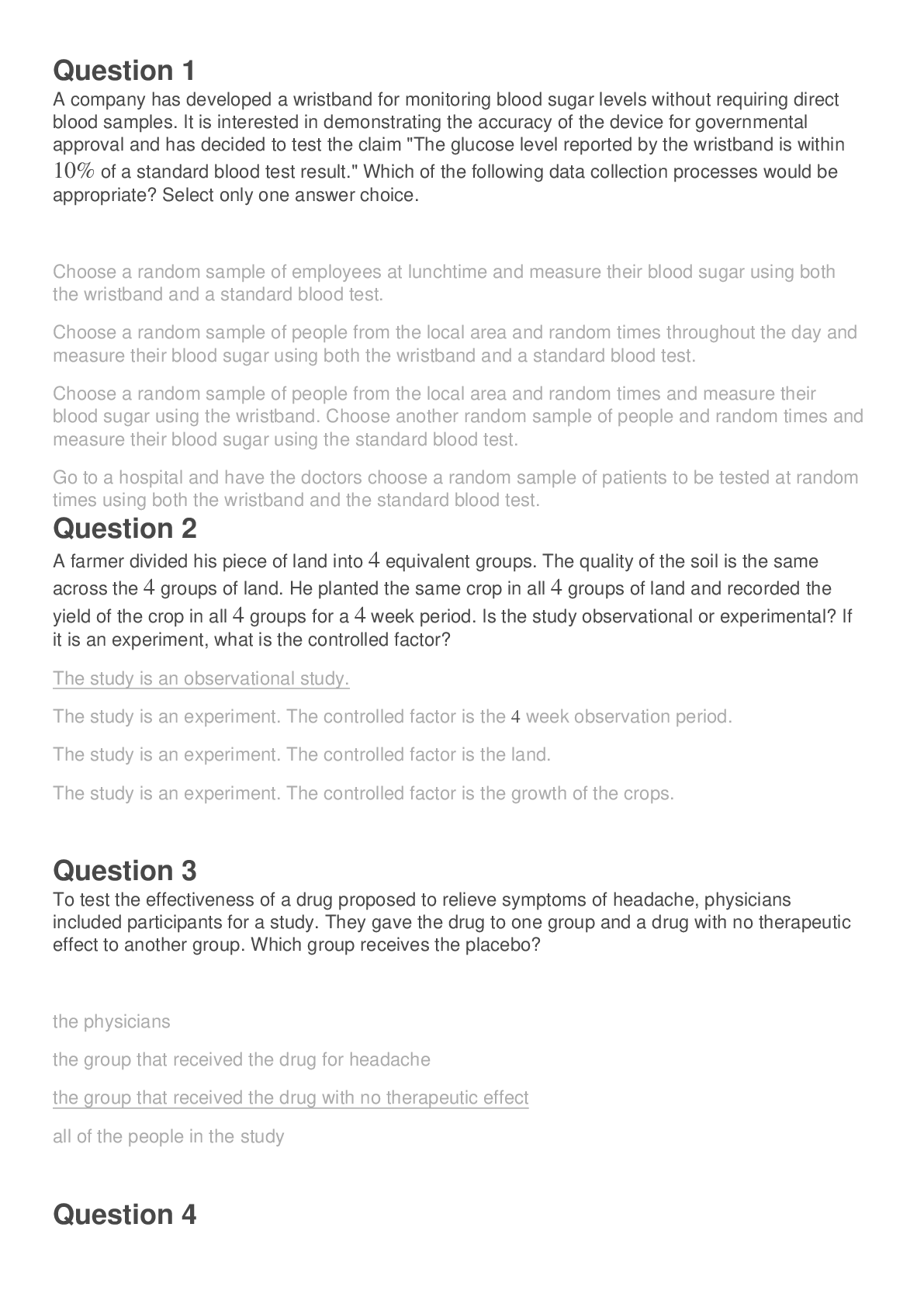
.png)

